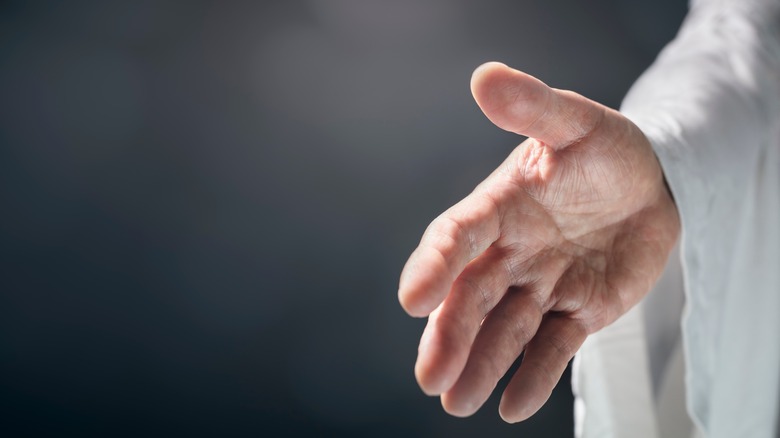Obsessive compulsive disorder (OCD) is a complex mental health condition (via Biological Psychiatry). No one knows exactly what causes and drives the illness, though researchers have continued to investigate its origins.
People with OCD can spend hours each day performing repetitive compulsive behaviors, according to Biological Psychiatry. These rituals are described as being avoidant rather than habit-driven: Patients do them to keep themselves safe and avoid danger. Without these compulsions, they fear that something dreadful will happen. People with OCD are not delusional — they recognize that their thoughts and behaviors are irrational, yet, they continue to rely on their rituals to quell their anxiety.
When people think of OCD, there are many popularized narratives that may come to mind: The germaphobe, the hand-washer, the person with a meticulous cleaning ritual. But the symptoms of OCD are far more diverse than you may realize (via the Child Mind Institute). Not everyone struggling with the disorder will experience the same symptoms. Some behaviors are obvious, whereas others are subtle and can go unnoticed for quite some time. Here are some signs of OCD that you might not know about.
Intrusive thoughts

This one may seem obvious. Recurrent and persistent thoughts are a key part of the diagnostic criteria for OCD (via Nature Reviews Disease Primers). However, up to 80% of people without OCD also experience intrusive thoughts from time to time (per OCD-UK). So, you may not necessarily know that you’re struggling with the disorder.
OCD is made up of two key elements: Obsessions, which manifest as intrusive thoughts, and compulsions, which can be mental or physical, according to OCD-UK. Obsessions can have different themes and are experienced differently depending on the individual. They may take the form of images, urges, worries, doubts, or even a combination of these.
Intrusive thoughts are not always indicative of an underlying condition, explains Nature Reviews Disease Primers. A person may be diagnosed with OCD if their obsessions or compulsions take up a lot of time (more than an hour a day) and cause considerable “distress or impairment” in their life. The individual will attempt to alleviate their anxiety by trying to avoid, suppress, or neutralize their thoughts with another thought or action.
Many people with OCD are misdiagnosed with another psychiatric condition, such as ADHD, notes a study published in the Journal of Affective Disorders Reports. Others live with the disorder for years without seeking help or receiving a diagnosis.
Hyper-Responsibility

Hyper-responsibility, also known as “inflated responsibility,” is the belief that we have the power to both produce and prevent negative outcomes (via Cognitive Behaviour Therapy). This is an important concept that’s central to the psychopathology of OCD. It’s one of the many cognitive distortions that tend to affect people with the disorder.
It’s common for people with OCD to have an increased sense of responsibility for others, and they generally overestimate their role in different situations (via Psychiatry Research). They may think it’s up to them to protect the safety of their friends, loved ones, and even strangers. Some people believe that not preventing a bad event from happening is equivalent to actually causing it, notes a study published in Clinical Practice and Epidemiology in Mental Health. This can lead to hypervigilant and controlling behaviors in an attempt to ward off danger.
People with OCD recognize the irrationality behind their beliefs (via Biological Psychiatry). However, a person with inflated responsibility may fixate on the idea that they’re able to cause things that are outside of their control, like natural disasters and accidents (via Psychiatry Research). They then experience tremendous guilt and blame themselves when bad things happen.
Fear of emotional contamination

pathdoc/Shutterstock
A fear of contamination due to germs, dirt, viruses, and other substances is a common feature of OCD (via Frontiers in Psychology). An individual may feel anxious about contracting a physical illness or infection. Some individuals also fear that they might become contaminated by another person’s mental state — their thoughts, beliefs, memories, or the images in their mind.
Emotional contamination, also known as mental contamination, is one of the lesser known symptoms of OCD, per the International OCD Foundation. Patients sometimes worry that they might “catch” someone else’s attitude, values, or personality traits in the same way that they could be infected with a disease. Some people are anxious about contracting a mental illness or disability.
Intrusive thoughts about emotional contamination can feel terrifying (via International OCD Foundation). People often develop safety behaviors to help them cope. They may try to avoid the feared person, or specific places where this person has been. Some individuals have cleaning rituals in case they do come into contact with the person. Others have superstitious rituals, such as repeating certain words, phrases, or actions.
These compulsive habits are intended to help people avoid unwanted outcomes, providing a false sense of safety, according to the Cognitive Behaviour Therapist. Although they may temporarily relieve anxiety, in the long run, these behaviors keep people stuck in a loop of distressing thoughts, emotions, and rituals.
Intolerance of uncertainty

eldar nurkovic/Shutterstock
Intolerance of uncertainty has been linked to a number of psychological conditions, including anxiety, posttraumatic stress disorder (PTSD), and OCD (via the Journal of Anxiety Disorders). It’s common for people to feel uncomfortable with uncertainty to some degree. But some individuals find the unknown particularly hard to face or wrap their head around, and a select few find it unacceptable and even debilitating.
Your intolerance of uncertainty could be clinical if uncertain situations feel dangerous, stressful, and upsetting, explains the Journal of Anxiety Disorders. Some people believe that a lack of certainty will compromise their ability to function. You may experience an overwhelming need to avoid uncertain situations or to do things that create a sense of security, such as acting out a ritual that provides an anchor of reassurance. People who have a hard time with uncertainty also struggle to tolerate the emotions and physical sensations that uncertainty evokes in them (via Journal of Anxiety Disorders).
“Figuring it out” is a common mental compulsion that’s intended to provide relief, per the International OCD Foundation. The point is to analyze and think about a situation so meticulously that you remove any semblance of doubt. But like most mental rituals, this behavior doesn’t give the person with OCD the answer they’re looking for. Instead, it feeds their anxiety even more. Overcoming the intolerance of uncertainty involves recognizing and accepting that the search for complete certainty is futile.
Magical thinking

Prostock-studio/Shutterstock
The idea that thoughts are the same as actions is one of the hallmarks of emotional contamination, notes the International OCD Foundation. A person with OCD may believe that having a thought or saying something out loud can make an event actually happen, a phenomenon that’s known as ‘magical thinking’ (via Frontiers in Psychiatry). They may find it hard to accept that they cannot always control the thoughts that enter their mind.
From this perspective, thoughts and words carry the same moral weight as actions, explains Frontiers in Psychiatry. So, if the person with OCD has an intrusive thought or talks about harming a loved one, they will feel immensely guilty, as if they had carried out that action. They may question whether having this thought indicates that they actually want to harm their loved one, and may be concerned about the other person’s safety.
The fear that thoughts could set off real-life negative consequences can become all-consuming for some people, disrupting their day-to-day functioning (via NOCD). In order to cope, some people develop compulsions like repeating certain phrases a specific number of times, or they counter bad thoughts with three positive ones. They tell themselves that will prevent something bad from happening. Patients may become dependent on their compulsions for a sense of relief and not performing them can feel anxiety-inducing.
Overestimation of threats

fizkes/Shutterstock
Another common cognitive distortion among people with OCD is the overestimation of threats (via Frontiers in Psychology). Patients often view certain situations and events as posing a far greater danger than they actually do. They’re more likely to detect a threat where there isn’t one or magnify an existing problem. They exaggerate the consequences of making a mistake or doing something imperfectly (via Clinical Neuropsychiatry). And they tend to go with worst-case outcomes as their default setting (via Proceedings of the National Academy of Sciences of the United States of America).
Due to these unhelpful patterns of thinking, the person develops compulsions like excessive checking to help them cope (via PNAS). They revisit and redeliberate decisions about specific things, such as whether they turned off the stove or locked the door. These repetitive actions are geared toward providing a sense of reassurance, but tend to exacerbate their anxiety instead. People with OCD often lack trust in their ability to cope if unwanted scenarios were to unfold.
“Overestimating the occurrence of threatening events has been highlighted as a central cognitive factor in the maintenance of obsessive-compulsive disorder” (via Behavior Therapy). An important step toward recovery is challenging and reappraising the actual danger associated with a feared outcome, notes a study published in the Journal of Obsessive-Compulsive and Related Disorders. This entails learning how to differentiate between rational and obsessional doubts: For example, washing one’s hands after grocery shopping is reasonable in the context of a pandemic, whereas repetitive washing is a compulsive behavior that usually makes things worse. The patient can gradually learn to tease these apart.
Body hyperawareness

Kmpzzz/Shutterstock
Hyperawareness, or sensorimotor OCD, is a subtype of OCD where people become fixated on natural bodily functions, such as blinking, breathing, or swallowing (via International OCD Foundation). If you’re suffering from sensorimotor obsessions, you may feel anxious that these involuntary processes are going to stop working on their own if you don’t pay attention to them. You may become hyper-conscious of a certain body part, such as your hand, foot, tongue, or face. Often, people develop the habit of constantly checking for marks, growths, injuries, or changes in appearance.
Research shows that people who suffer with sensorimotor obsessions have heightened interoceptive sensitivity — that is, a stronger ability to detect and tune in to internal signals originating from the body (via Journal of Obsessive-Compulsive and Related Disorders). This can sometimes be helpful but it can also cause more anxiety and distress about unpleasant sensations. For example, they may worry that this means something isn’t quite right, which can give rise to repetitive behaviors that are intended to resolve discomfort and stress. These individuals have a greater tendency to perceive their body as unsafe and untrustworthy, which often underlies obsessive thoughts and compulsive behaviors.
Hoarding

Maridav/Shutterstock
Hoarding behavior is common in people with OCD (via Psychiatry Research). Hoarding was once deemed a sub-type of OCD, but it’s now also treated as its own unique condition known as hoarding disorder. The main difference between hoarding disorder and hoarding OCD is that people with hoarding disorder accumulate stuff because they consider them to be valuable (via OCD-UK). People with OCD, on the other hand, acquire items due to obsessive thoughts and urges. For instance, they may fear that something bad or catastrophic will happen if they don’t have a particular item at home or if they get rid of it.
Hoarding associated with OCD generally doesn’t bring a person any pleasure but rather tends to cause them a significant amount of distress and anxiety (via OCD-UK). People may have seemingly practical or purely superstitious reasons for collecting things. But it’s not uncommon for people to justify holding on to things that have little use or value.
Unsurprisingly, OCD-driven hoarding and panic shopping increased in the wake of COVID-19, reports a 2024 study published in Psychiatry Research. People began stockpiling supplies like soaps, sanitizers, masks, medications, and disinfectants. However, it’s not entirely clear how much of these behaviors were healthy responses to a global pandemic or subclinical and clinical symptoms of OCD, according to a 2024 study from the Journal of Psychiatric Research.
Avoidance

eldar nurkovic/Shutterstock
It’s natural for you to want to keep away from situations, places, or people that feel dangerous. For people with OCD, however, avoidance can become compulsive and may cause distress in and of itself (via Biological Psychiatry). For instance, a person with a fear of contamination may persistently avoid public places where they fear they might catch germs (via PsychCentral). Some people go to extreme lengths to avoid distressing thoughts and emotions. Others avoid specific numbers, words, colors, or songs that don’t quite “feel right” (via BeyondOCD.org).
Avoidance may serve as a temporary coping mechanism, according to PsychCentral. But in the long term, this behavior exacerbates OCD symptoms, such as intrusive thoughts, rituals, compulsions, and feelings of anxiety. A key part of an OCD treatment known as exposure and response prevention (ERP) is questioning and distancing oneself from intrusive thoughts and learning to confront feared situations in a controlled way. This can help patients step out of the cycle of obsessive thoughts and compulsions and gradually unlearn their fear responses.
Perfectionism

kasarp studio/Shutterstock
Perfectionism is a common personality trait that exists on a spectrum (via BMC Psychology). It doesn’t necessarily cause significant emotional distress and impairment for everyone who experiences it. Perfectionism, on the more severe end of the spectrum, however — also known as “maladaptive perfectionism” — can interfere with day-to-day functioning. This manifests as the need to meet unrealistic expectations and standards, and has been found to cause depression, hopelessness, neuroticism, and suicidal thoughts.
Maladaptive perfectionism can often show up in those struggling with OCD (via Frontiers in Psychiatry). Individuals may become overly preoccupied with setting goals, doing things in a very specific way, and preventing and avoiding errors. The idea of making a mistake or doing something imperfectly can feel unacceptable, if not deeply anxiety-inducing. Perfectionism can often underlie checking compulsions that are driven by the inkling of things “not being right.” It can also lead to other OCD symptoms, such as repeating simple tasks over and over again (via Journal of Affective Disorders).
Confessing

Brian A Jackson/Shutterstock
Given the individualistic nature of the disorder, some OCD symptoms can fly under the radar (via OCD Types). For instance, a commonly overlooked sign of OCD is the urge to confess. This can sometimes affect people with OCD who are religious. They may experience guilt and shame over their intrusive thoughts and obsessions. Some people even have fears of being punished and going to hell.
Individuals with OCD may experience a sense of urgency to confess their “bad thoughts” to others, explains OCD Types. The types of thoughts that people choose to reveal can vary in severity. Some people believe that they must always tell the truth and disclose every little detail about a situation, while others may describe their thoughts as if they had already happened. While confessing tends to provide short-term relief, it keeps individuals trapped in a relentless circle.
One of the most effective treatments for breaking this painful pattern of ruminations and compulsions is exposure and ritual prevention therapy (ERP), per OCD Types. This can help patients learn how to resist their anxious thoughts and rituals. Given the wide array of symptoms associated with the illness, therapies should be tailored for OCD and are best practiced under the guidance of a specialist, according to research (via Clinical Psychology: Science and Practice).
Self-punishment

Bits And Splits/Shutterstock
A person with OCD who fears that they might be “bad” or dangerous often experiences profound guilt and shame (via Cognitive Therapy and Research). As a result, they may mentally punish themselves in various ways. This is perpetuated by the erroneous idea that we should be able to control our thoughts at all times, and that “wrong” thoughts are as bad as wrong actions.
Self-punishment can include telling yourself how “bad” you are, regularly and repeatedly (via OCD Specialists). Some people emotionally abuse themselves, either internally or out loud, in order to feel a sense of justice. This may stem from a desire for retribution, namely not wanting to let themselves “get away” with their unethical thoughts.
Self-punishment can serve as a thought control strategy and a form of self-motivation for a person with OCD, notes Cognitive Therapy and Research. They may think that by punishing themselves, they’re deterring themselves from wanting to engage with these thoughts and obsessions in the future. But this behavior simply continues to act as a compulsion.
Reassurance seeking

MDV Edwards/Shutterstock
People seek out reassurance in different ways. For an individual with OCD, the purpose of reassurance seeking is to reduce fear, doubt, or uncertainty (via BMC Psychiatry). Some researchers describe this as an attempt to “put things right” — the person with OCD may be looking for words of comfort from others. They may want some validation that they took the necessary steps to prevent something harmful from happening. In this case, gaining reassurance can take some of the responsibility off their shoulders.
But the need to be reassured tends to become excessive in OCD, where it starts to provoke anxiety rather than relieve it (per BMC Psychiatry). Some individuals may ask the same questions repeatedly. They may engage in long, circular conversations about their feared situation with friends, family members, and acquaintances, yet, they never get the reassurance they’re looking for.
Over time, reassurance seeking becomes a compulsion, according to BMC Psychiatry. This can be incredibly frustrating for both the sufferer and the people in their life. Research indicates that excessive reassurance-seeking behaviors often create relationship problems and fuel the vicious OCD cycle.




